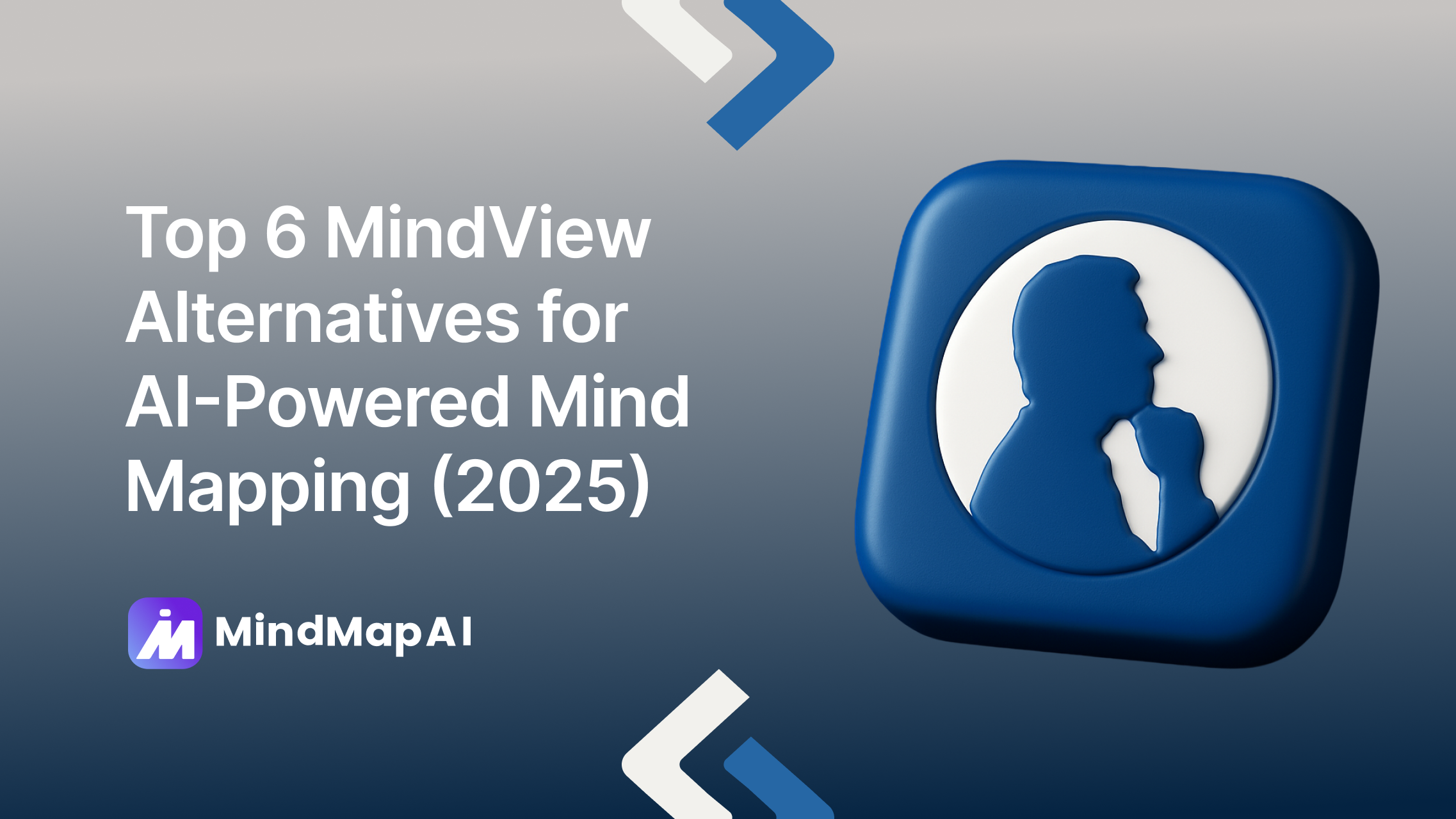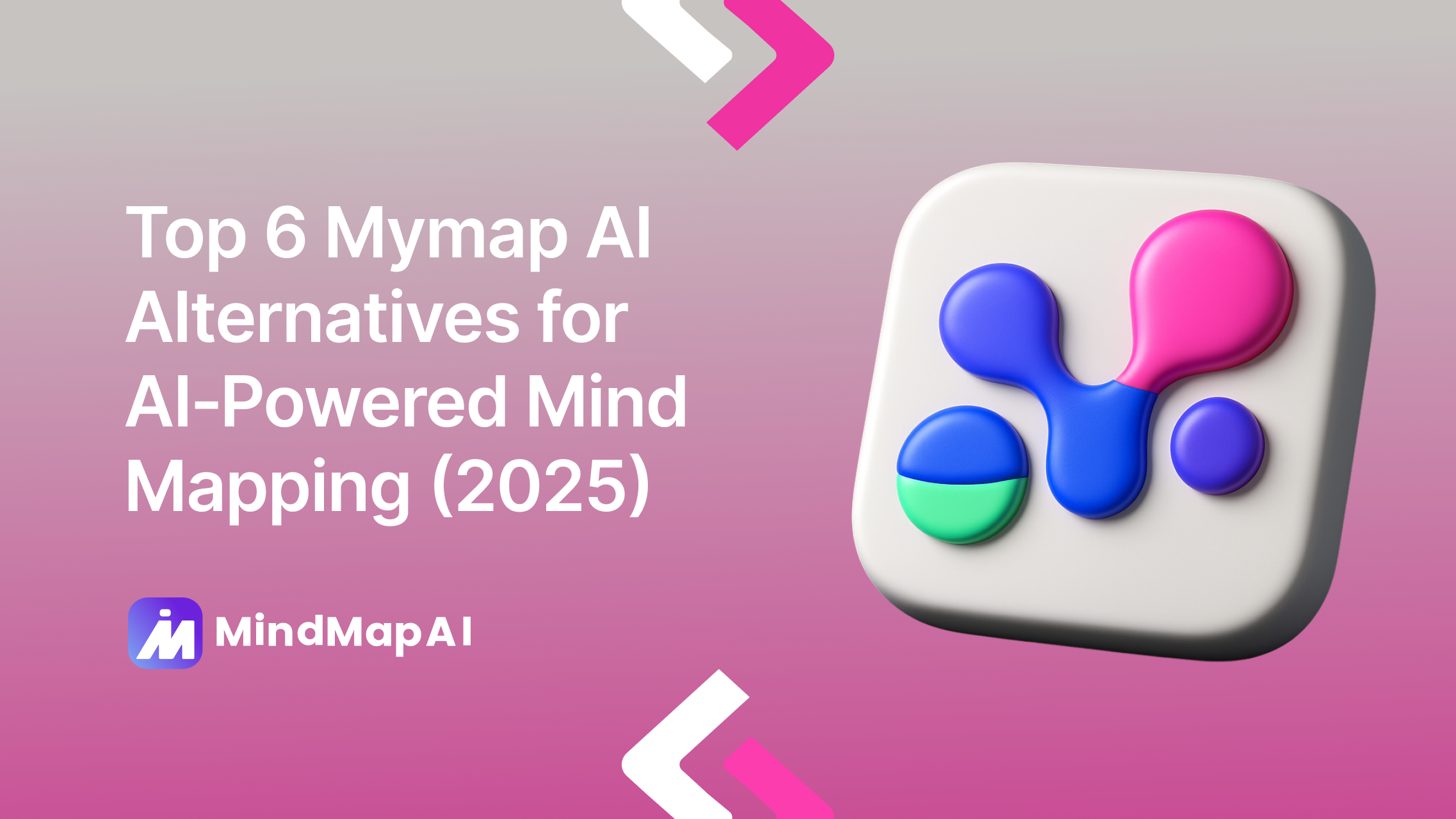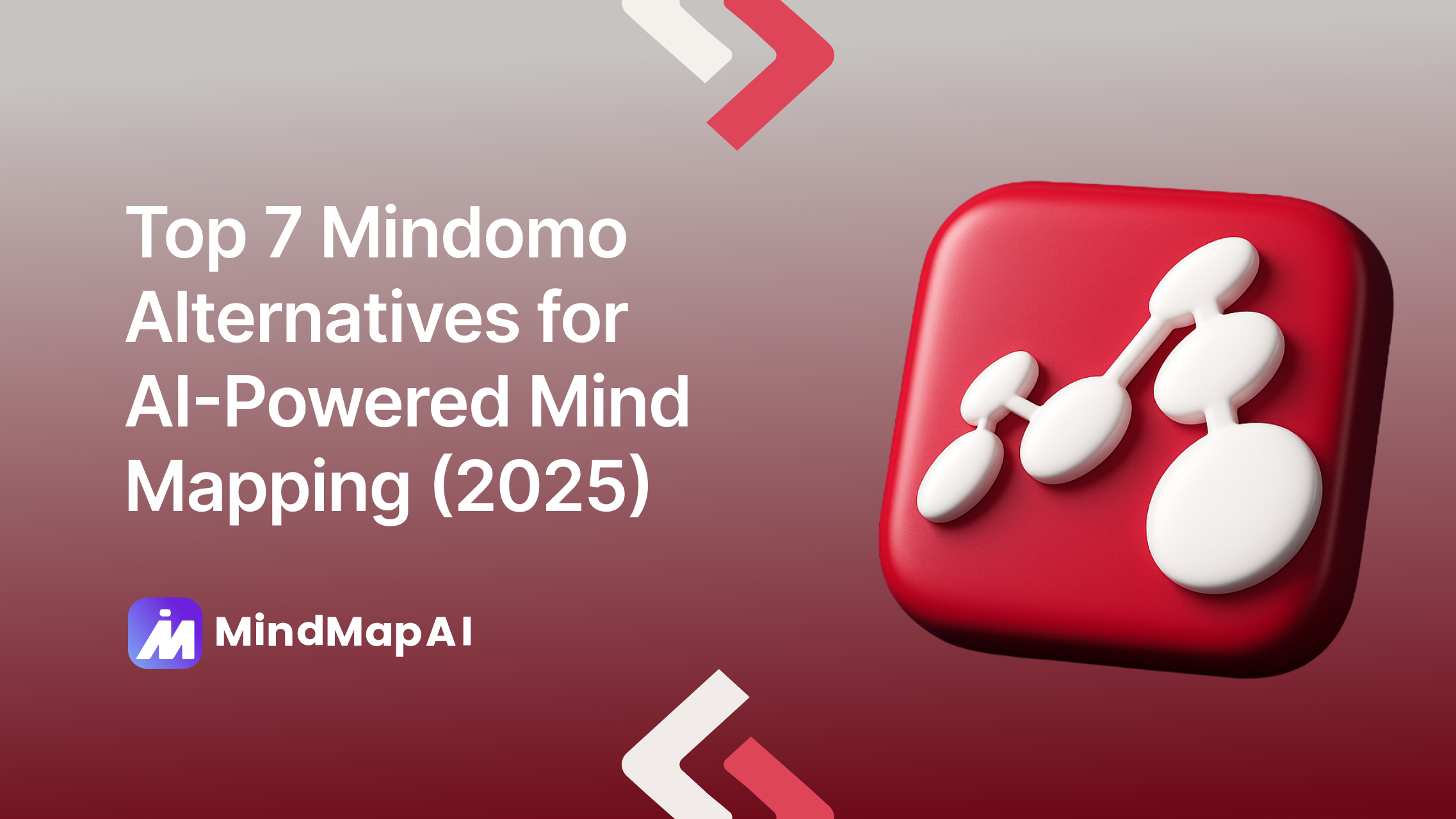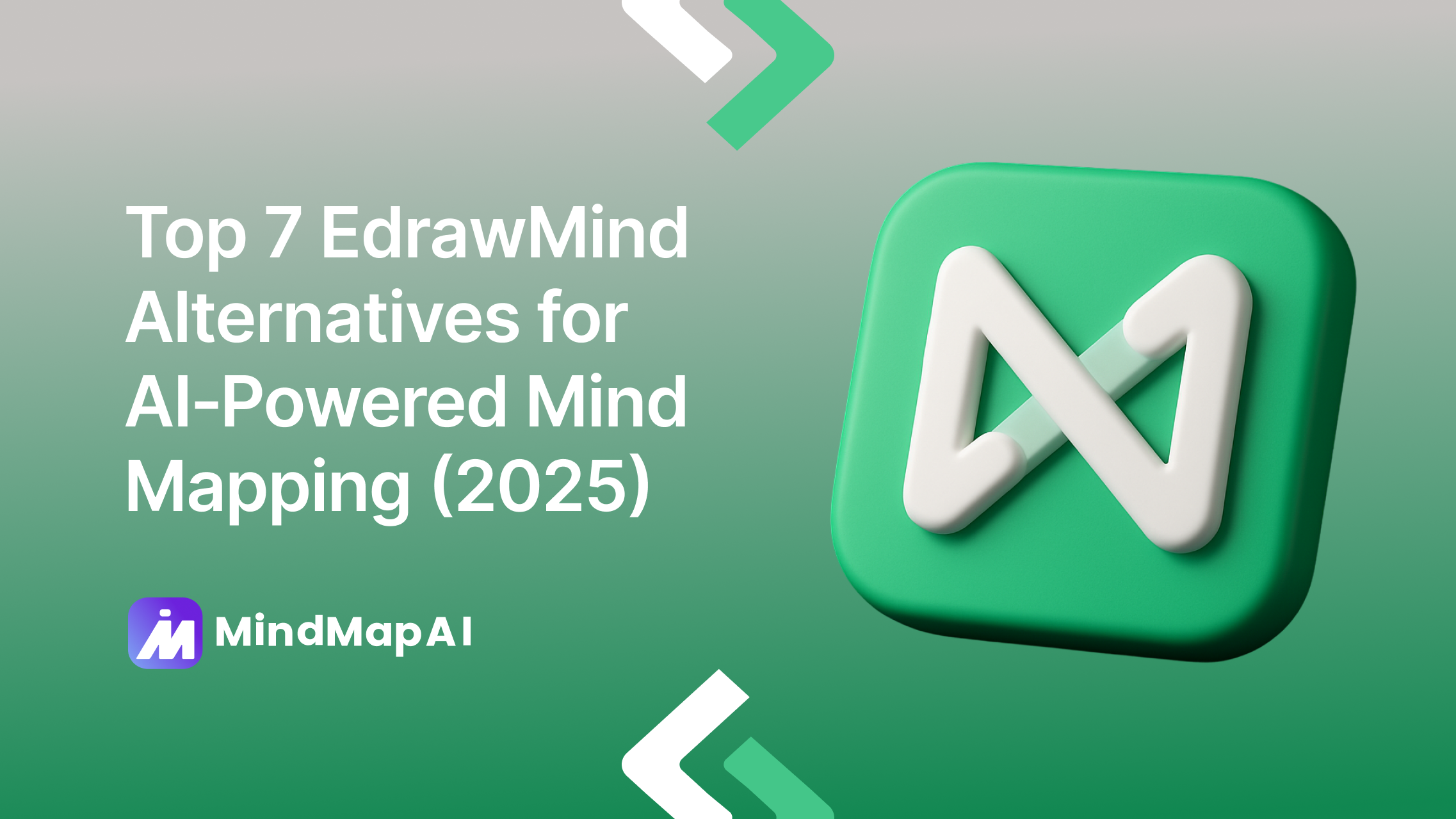
Top 7 EdrawMind Alternatives for AI-Powered Mind Mapping (2025)
EdrawMind is a feature-rich mind mapping platform that blends AI assistance, real-time collaboration, and an extensive library of templates to help you brainstorm, plan, and present ideas. With tools for creating Gantt charts, converting maps to slides, and switching between outline and visual views, it appeals to students, educators, and teams seeking a versatile all-in-one solution.
However, EdrawMind’s comprehensive feature set may not be the perfect match for everyone. Some users may prefer a platform with more advanced AI generation capabilities, broader content import options, or lighter, faster workflows. Others might be looking for tools that specialize in AI-powered summarization, multi-format mapping, or unique customization features.
That’s why we’ve curated this list of the best EdrawMind alternatives for 2025, platforms that offer fresh approaches to AI-driven mind mapping, with the flexibility to adapt to your specific needs.
Ready to create your AI mapping?
1. MindMap AI

Why it stands out
MindMap AI redefines modern mind mapping by combining real-time AI assistance with support for multi-format content, making it a top alternative to traditional tools like EdrawMind. Users can effortlessly drop text, PDFs, images, audio, video, or CSV files into the platform and instantly generate structured, editable mind maps. Its AI Copilot Chat continually refines and expands ideas as you brainstorm, while AI Summarization and Topic Focus help condense large amounts of information into actionable insights.
Additionally, Second-Order Connections automatically detect hidden links and relationships across nodes, giving users a deeper understanding of their ideas and uncovering patterns that might otherwise go unnoticed.
Key Features
Real-Time AI Copilot Chat: Continuous, on-canvas natural-language prompting for expansion, summarization, or next-step actions.

AI Summarization & Topic Focus: Instantly condense complex branches or zero in on specific topics with plain-English commands.

Second-Order Connections: Automatically uncover and link related concepts for deeper insights.

Multi-Format Input & Export: Generate maps from text, PDF, image, audio, video, CSV and export to PNG, SVG, PDF, Markdown, or CSV.

Pros
Continuous AI assistance keeps brainstorming fluid without re-triggering prompts.
Advanced AI capabilities (summarization, topic focus, second-order links and AI expand) deliver richer insights than basic AI tools.
Broad input or output support handles almost any content type.
Generous free plan with unlimited manual mapping and watermark-free exports.
Flexible pricing monthly, annual (Basic $45/yr; Pro $90/yr), or lifetime licenses with add-on credits.
Cons
No real-time collaborative editing teams share view/comment links instead.
More limited theme and styling customization compared to some desktop apps.
Pricing
Free: 100 AI credits/month + unlimited manual maps
Basic: $7.49/month or $45/year (2,000 AI credits)
Pro: $14.99/month or $90/year (5,000 AI credits)
Lifetime: One-time licenses with bundled credits available
Curious how MindMap AI stacks up against EdrawMind?
2. Mindomo

Why it stands out
This tool combines familiar radial maps, outlines, and Gantt views in one workspace, with a desktop mode that works fully offline. The Premium plan starts at €6/month (~$6.50) with 50 AI credits, while the Professional plan increases to 60 credits enough for regular weekly lessons or brainstorming sessions.
Its integrations with learning management systems and Microsoft Teams make it particularly useful in education and training environments.
Key Features
Seamless switching between map, outline, and Gantt views.
Shared AI credit pool on Team plans for collaborative use.
Integrations with LMS platforms and Microsoft Teams.
Pros
Strong free tier with up to 3 maps.
Desktop app for offline mind mapping.
Cons
Lower AI quotas compared to some competitors.
No video or audio ingestion capabilities.
Pricing
Free plan available.
Premium at €6/month.
Professional at €13.50/month (includes 1 user + 5 guests).
3. Mapify
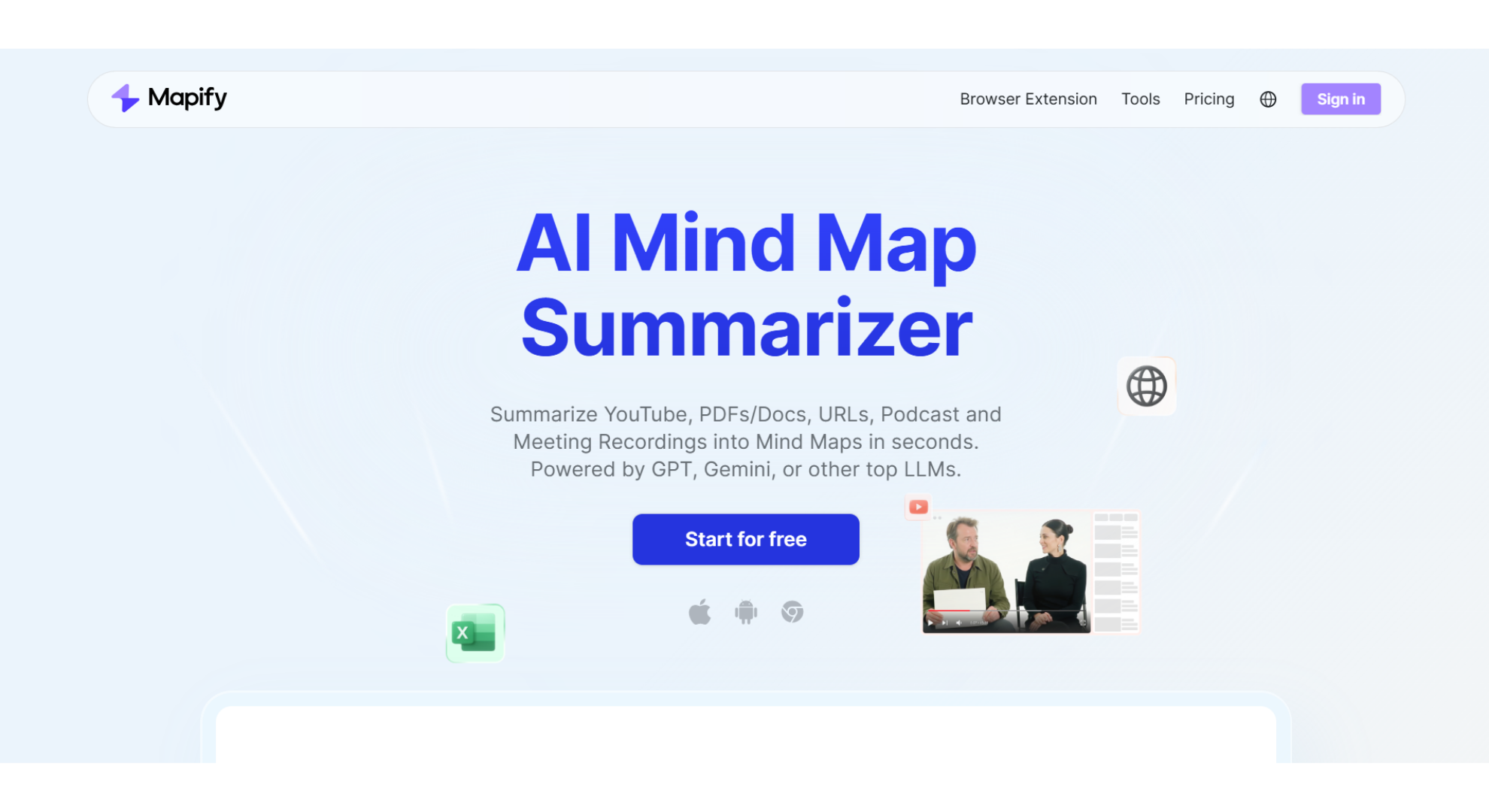
Why it stands out
Simply drop in a dense PDF, PowerPoint, or YouTube link and receive an AI-generated radial mind map plus an optional slide deck in seconds. The platform’s speed and minimal interface make it perfect for users who need quick, clean visualizations without extra setup.
Key Features
Converts PDFs, documents, URLs, YouTube videos, and MP3/MP4 files into mind maps.
Built-in slide deck export and translation into over 30 languages.
“Chat with your file” Q&A panel for interactive content exploration.
Pros
Extremely fast file-to-map processing.
Clean, distraction-free user interface.
Cons
Supports only radial layouts.
No Kanban or Gantt view options.
Basic plan capped at 1,000 AI credits.
Pricing
Free plan available.
Basic at $9.99/month (often $5.99 with 40% promotion).
Pro at $19.99/month.
4. MindView
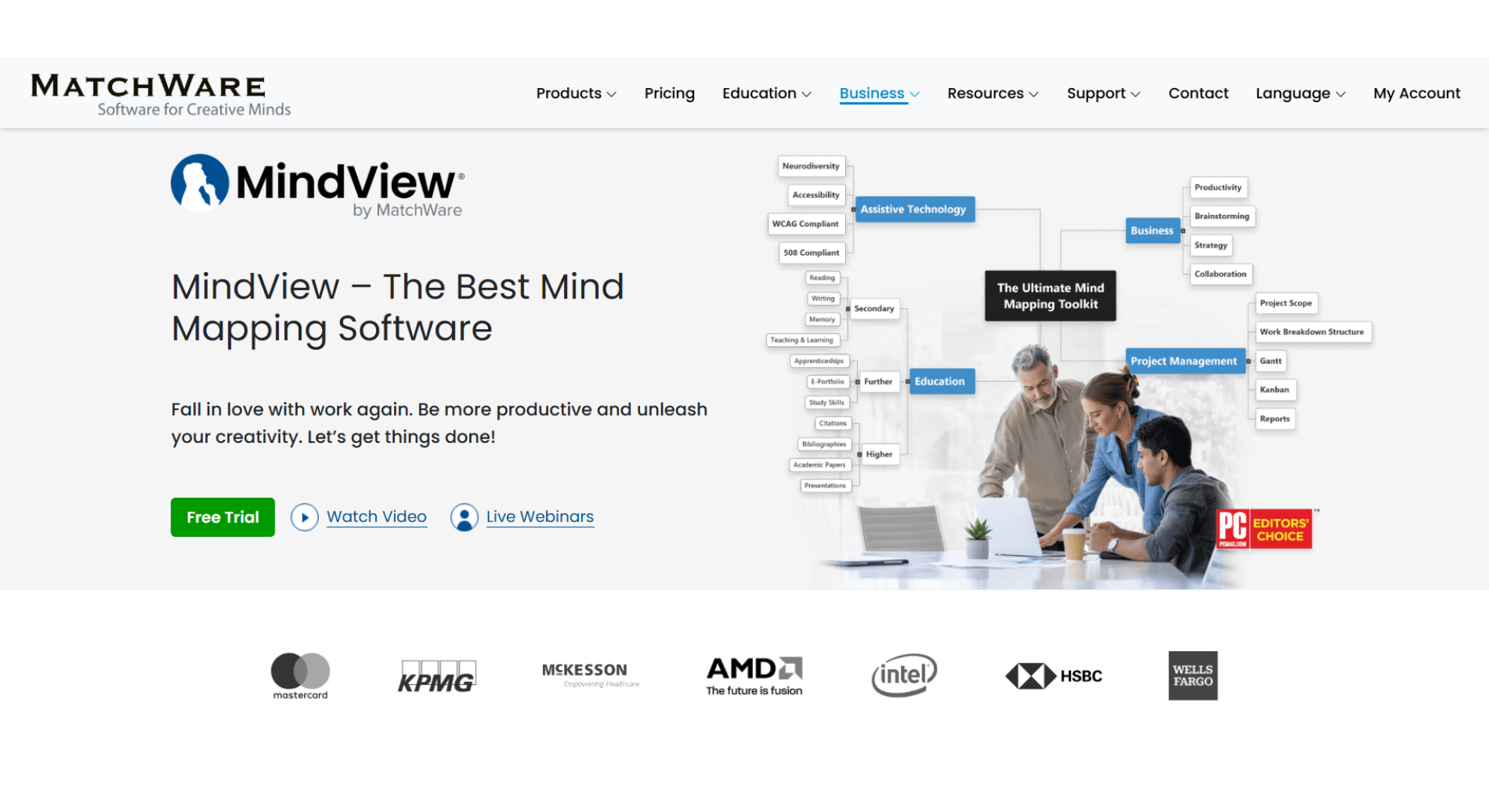
Why it stands out
With a single click, this platform transforms any mind map into fully editable Gantt or Timeline views, while keeping all data synced. It includes task cost fields, baseline snapshots, and full round-trip integration with Microsoft Project, making it a powerful choice for professional project scheduling and management.
Key Features
Six synchronized views, including Map, Gantt, Timeline, WBS, and more.
Integration with Microsoft Office and MS Project for seamless data exchange.
Baseline snapshots for tracking schedule and budget variances.
Pros
Comprehensive scheduling and cost management within a mind mapping tool.
Desktop-level performance with optional cloud saving.
Cons
Highest pricing in this comparison list.
AI summarizer is not yet publicly available.
Pricing
Suite subscription at $20/month (1-year term).
$17/month (2-year term).
$15/month (3-year term).
5. GitMind
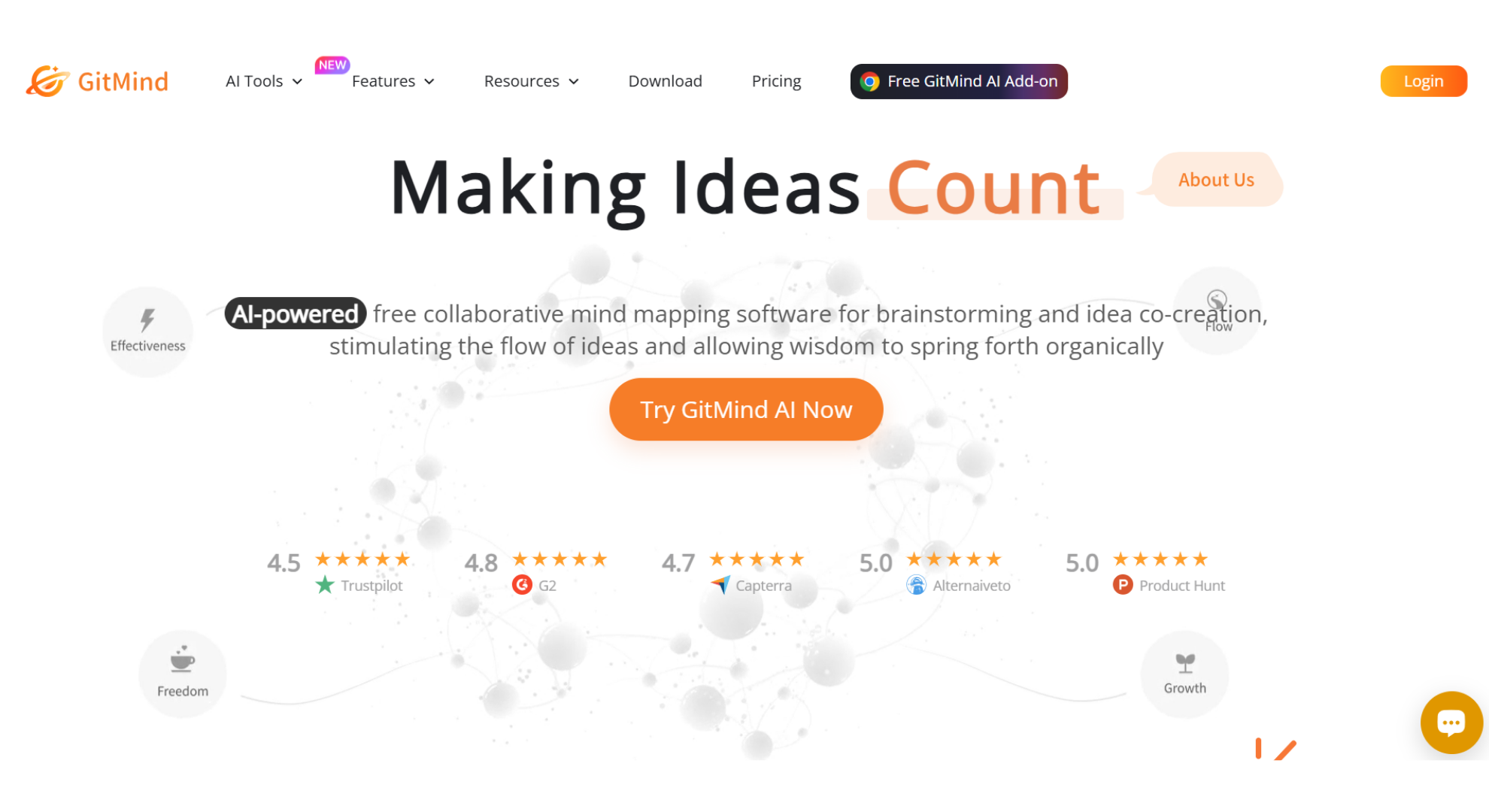
Why it stands out
This platform offers unlimited free maps with real-time collaboration, making it especially attractive to students and teams on a budget. The Annual Pro plan costs just $4.08/month and adds 2,000 AI credits plus HD export, providing exceptional value for under $5 per month.
Key Features
Drag-and-drop creation for mind maps, flowcharts, and slide show presentations.
“Planet” team spaces supporting up to 30 members each.
Cross-platform sync across web, iOS, Android, and desktop apps.
Pros
Largest free map allowance among all tools in this list.
HD export and slide mode available on paid tiers.
Cons
No built-in Gantt or Kanban views.
Fewer third-party integrations than some competitors.
Pricing
Free plan available.
Monthly plan at $9.
Annual plan at $4.08/month (billed yearly).
6. MyMap AI
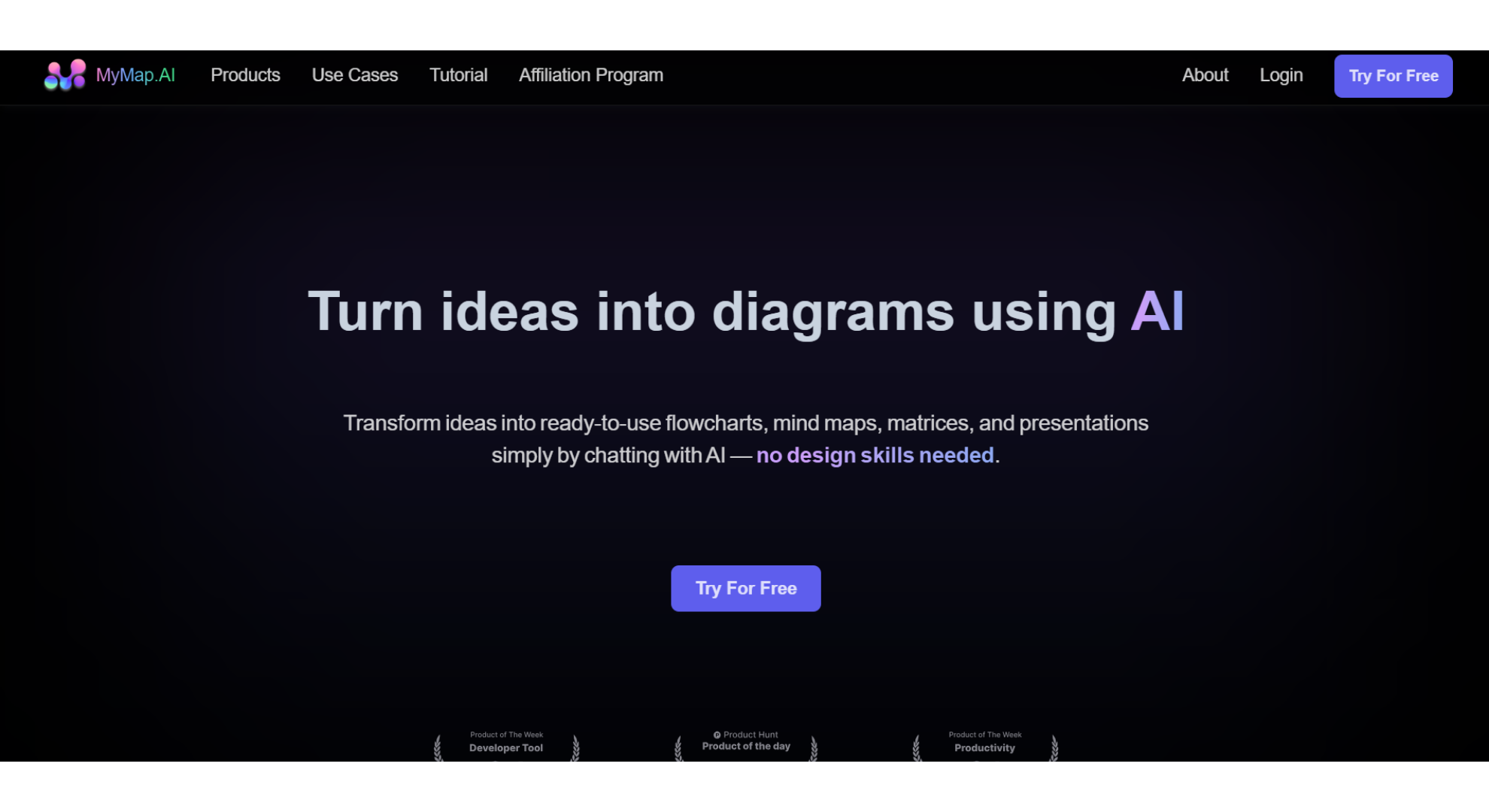
Why it stands out
Type a prompt like “Launch Q4 campaign” and instantly receive a mind map, flowchart, and slide outline enriched with live web search results. Real-time co-editing and simple export options make it ideal for fast-moving teams that want fresh, data-backed visuals without manual layout work.
Key Features
AI chat that generates mind maps, flowcharts, matrices, and slide decks.
Real-time collaborative editing with PNG and PDF export options.
Web search integration to pull in the most up-to-date information.
Pros
No learning curve thanks to its chat-first interface.
Starter tier includes 5 free AI requests per day.
Cons
Higher starting price compared to many alternatives.
Limited third-party integrations at present.
Pricing
Plus at $15/user/month (or $9 billed yearly).
Pro at $20/month.
Team Pro at $25/month.
7. MindGenius Online
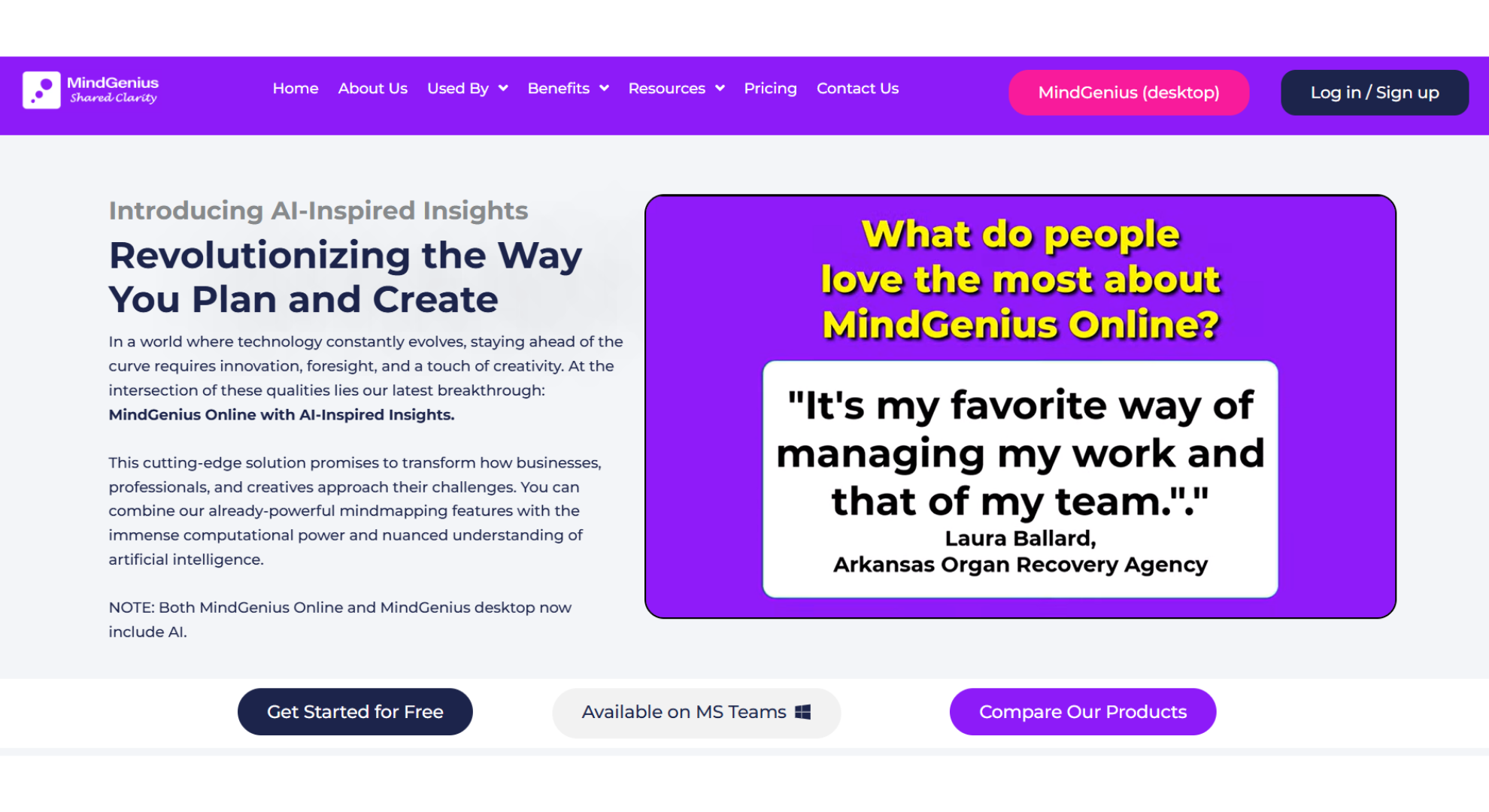
Why it stands out
This tool lets you brainstorm in a mind map, then switch to a timeline or Kanban-style taskboard while keeping dates, owners, and task details intact. It’s designed with project managers in mind, offering a seamless way to move from ideation to execution without data loss.
Key Features
Toggle instantly between map, timeline, and taskboard views.
Unlimited projects and dashboards with a subscription.
Guest links and Microsoft Teams embedding for easy sharing.
Pros
Built-in dashboards for tracking KPIs and progress.
14-day free trial to test all features.
Cons
AI is limited to simple idea prompts rather than advanced automation.
Web interface looks dated compared to newer SaaS competitors.
Pricing
MindGenius Online at £10/seat/month (~$12.80), billed annually.
Not sure which fits your workflow?
Comparison at a Glance
| Tool | Entry price | Included AI quota | Stand-out strength |
|---|---|---|---|
| MindMap AI | $7.49/mo | 2 000 credits | Broadest file ingest |
| Mindomo | €6 (~$6.50) | 50–60 credits | Budget & LMS-ready |
| Mapify | $9.99/mo | 1 000 credits | Fast file-to-map |
| MindView | $20/mo (1-yr) | – | Map ↔ Gantt switch |
| GitMind | $4.08/mo | 2 000 credits | Free-forever maps |
| MyMap AI | $15/user/mo | 5 req/day free | Chat-driven diagrams |
| MindGenius Online | $12.8/seat/mo | Idea prompts | Map → Timeline/Taskboard |
FAQ
Q: What is the best alternative to EdrawMind in 2025?
A: The best all-round alternative is MindMap AI, with broad file support (PDFs, images, videos, audio, CSVs) and advanced AI copilots for summarization, expansion, and second-order connection. For project scheduling, MindView is also a strong contender.
Q: Which tool offers the strongest AI features?
A: MindMap AI leads with continuous Copilot Chat, AI Summarizer, Topic Focus, and Second-Order Connections. For a chat-native approach, MyMap AI also provides real-time map generation enriched with live web data.
Q: Is there a cheaper alternative to EdrawMind?
A: Yes. GitMind is the most budget-friendly, with an annual plan at $4.08/month including 2,000 AI credits. MindMap AI also delivers high value at $7.49/month for 2,000 credits and a robust free plan.
Q: Which tool is best for students?
A: MindMap AI is ideal for students, as it can turn PDFs, lecture audio, and images into structured maps. GitMind is another good option, offering unlimited free maps with collaboration features.
Q: What’s the most versatile EdrawMind alternative overall?
A: While GitMind is cheapest, MindView strongest for projects, and Mapify fastest for quick file-to-map use, MindMap AI is the most versatile EdrawMind alternative in 2025. It combines broad input/output formats, advanced AI copilots, and flexible pricing.
Final Takeaway
EdrawMind’s combination of mind mapping, project planning, and AI integration makes it a strong all-rounder, but it’s far from the only option. The best EdrawMind alternatives introduce different strengths, from real-time AI brainstorming to instant conversion of PDFs, videos, and audio into editable maps.
MindMap AI is one of the most compelling choices. It supports a wide range of content formats like PDF, text, images, audio, CSV, and more; and turns them into structured mind maps in seconds. With AI Expand, Summarize, and Focus Topic features, plus multiple export options it delivers both power and adaptability for individuals, educators, and teams.
If you’re seeking a mind mapping tool that combines AI creativity with a streamlined, highly customizable workflow, MindMap AI is well worth exploring.





